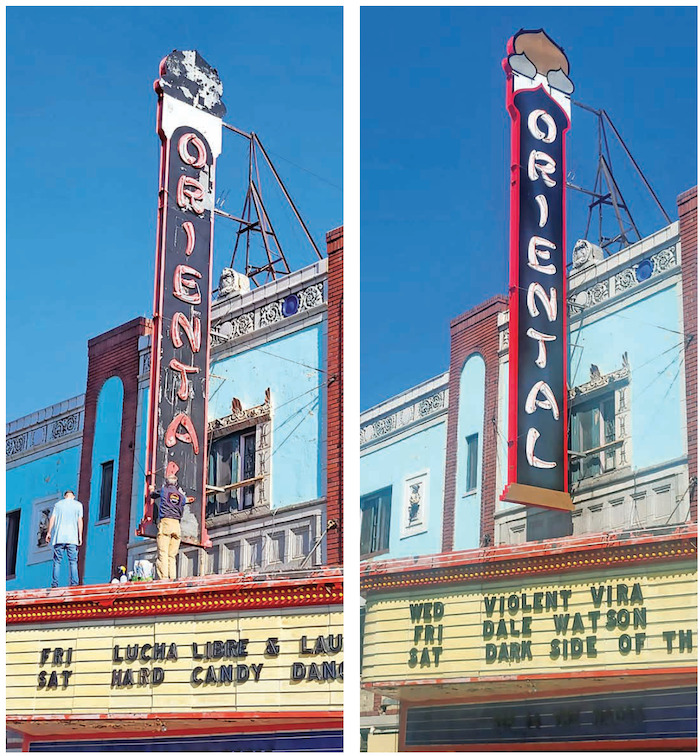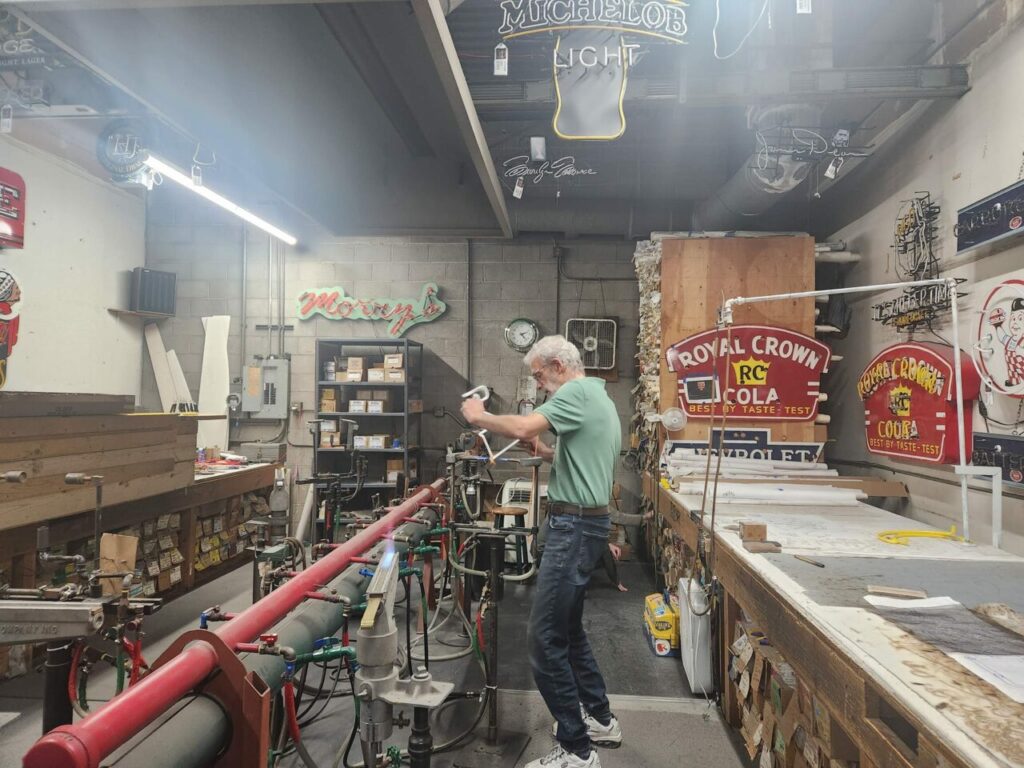By Kathryn White
An extensive restoration to the front of The Oriental Theater (called The O these days) reached a milestone last month. The tall vertical vintage sign above the theater’s marquee, the “blade,” was stripped down, restored, repainted and outfitted with new neon lettering.
Scott Happel, general manager and partner at The O, said of the project by Morry’s Neon Signs, “We’ve had two other companies in the 10 or 11 years I’ve been around that repainted the blade. Neither time did that repainting last successfully for any amount of time. What Morry’s has done with the blade just already immediately looks so good and correct. I have much more confidence that it will stand the test of time in a way that the last couple of attempts have not.”
“You can kind of see the history of the country in the sign,” said Morry’s general manager, Todd Matuszewicz. “It’s really cool, since it’s so old. In 1927 you had to be a licensed franchise of Claude Neon (Georges Claude), a Frenchman who claims to have invented neon, which is a whole other story.”

Photos by Glen Weseloh
Morry’s research leading up to the restoration uncovered pictures of the theater building over the course of nearly 100 years of updates. When The O’s blade was created in 1927, it featured three onion domes, often associated with the Russian Orthodox Church, at the top of the blade. It also incorporated a rippled tin that was popular in the 1920s and ’30s and white porcelain bushings where the neon met with electrodes on the back side of the sign face.
A marquee was added beneath the blade in 1936. A dragon replaced the onion domes. During this phase, a rare type of brown porcelain bushing was used to replace some of the original white ones. What makes them rare, according to Matuszewicz, is that these bushings were manufactured for a limited time by Coors during Prohibition. The company needed to rely on products other than beer to stay afloat.
Matuszewicz is the right man for a tour of Morry’s. He recently began a master’s degree in historic preservation at CU Denver in the College of Architecture and Planning. He began the tour with a lesson in the origins of the periodic table of elements dating back to the 1869 framework created by Russian chemist Dmitri Mendeleev. Chemists around the world worked to isolate each element that would ultimately find its place in a table scientists have added elements to as recently as 2016. Neon was isolated in 1896.
“Morry Weseloh started bending glass in Denver back in 1946,” Matuszewicz said. “He was part of a wave of people who came back from the war and were trained on the GI Bill.”
“Neon doesn’t travel well, it doesn’t ship well, and so that’s why they trained so many people,” Matuszewicz said. “There would be a neon tube bender that would have a region. All these little rural areas would have a shop that would service their hundred-mile radius.”
Morry’s Neon was founded in 1985 by Gary Weseloh, Morry’s son. The company’s namesake, who had headed up the local tube benders’ union at times, wasn’t ready to let go of the work. Morry’s other son, Glen, and Glen’s wife, Tina, now run the operation.

Morry Weseloh’s son Glen bends glass tubing in the
shop at Morry’s Neon Signs. Photo Courtesy of Morry’s Neon Signs
The crew of six who work for Morry’s today fabricate and repair signs; design, repair and construct neon; and process the combination of gases, glass colors and other materials that go into creating the vibrant colors neon is now capable of.
Other signs by Morry’s can be seen in North Denver at Billy’s Bar (44th and Lowell), Lucy’s Burger Bar on Tennyson and Little Man Ice Cream Factory on West Colfax.
Happel and the crew at Morry’s are not quite done at The O.
“They’ll be back to start work on the base of it, what most people would refer to as the marquee part,” Happel said. “That will be completely redone also, so all the paint will be scraped off and redone. The whole bottom of it that is rusty and kind of peeling off will be totally replaced with new metal. Once they are done done, the whole thing will look as good as the blade currently looks.”
Restorations to the blade and marquee will use the last of a Save our Stages grant The O received during COVID-19.
Of the building’s interior improvements, Happel said, “If you’re a person that has not been to an event at the theater in four or five years I think that you would find a lot of updates if you were to come tomorrow.”

Be the first to comment